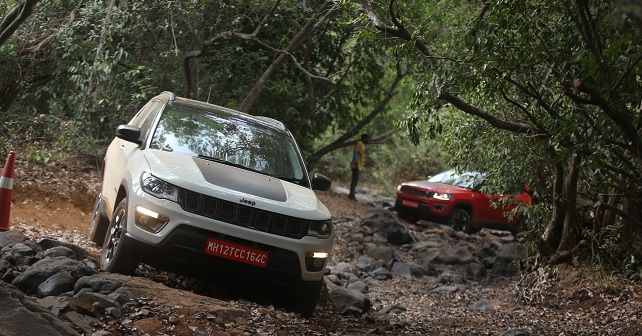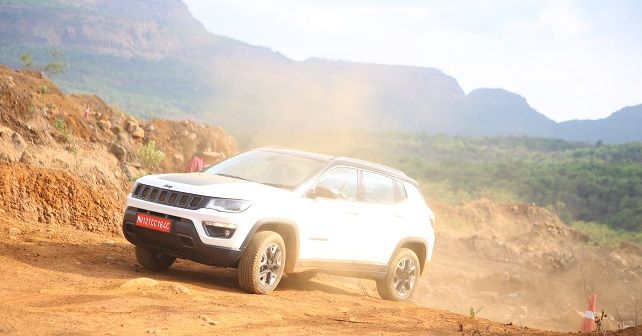Jeep Compass Trailhawk Review: First Drive
The Compass has now become the ‘Trail Ready’ Trailhawk. Jared finds out just what it’s capable of.
Just like Mercedes-Benz has its AMG vehicles and BMW has its M-Division, American SUV manufacturer Jeep has something pretty similar – only it doesn’t have anything to do with on-road performance. Yup, I’m talking about that badge of honour that reads ‘Trail Ready.’ A Jeep vehicle with this badge simply means that the vehicle is a proper off-roader and is capable of taking on anything that dares to come in its path.
The Compass itself is a highly versatile and beautiful machine. It even has the distinction of being our ‘Best of 2017’ machine – the year it was launched in India. It drives wonderfully in the city, and it can be quite capable off-the-road. But what if you want it to be a hardcore all-terrain conqueror? Well, then the new variant of the Compass, the Trailhawk, is the answer.
Earning the badge
The Compass Trailhawk looks exactly the same as the regular Compass, both inside and out. But, it’s not the same! There are minor details that set it apart. The most important differentiating factor is the tiny red badge that reads ‘Trail Ready.’ Being worthy of this badge is a serious affair, and the Jeep engineers have listed five criteria for a car to be Trail Ready.
The first and most important is traction. The Trailhawk gets ‘Jeep Active Drive,’ which is a full-time AWD system. It now also gets a special 4-Low mode that gives it a crawl ratio of 20:1, which no other SUV in this segment has. There’s also an added Selec-Terrain mode called ‘Rock.’ The driving modes control the amount of torque sent to the wheels through a very clever system, and the Trailhawk seems to be able to offer better torque management for traction than the Compass. Another added feature in the Trailhawk is the Hill Descent Control.
The next criterion is manoeuvrability, and, for this, the Trailhawk has been fitted with new all-terrain tyres. It also gets a new suspension setup in the form of an all-independent format and high structural stiffness for better handling, as well as Frequency Sensitive Damping and a Hydraulic Rebound Stopper. There are also skid plates to protect the underbody from any damage.
The last three criteria are ground clearance, articulation and water fording. For these, the Trailhawk’s ground clearance has been bumped up to 205mm and the front and rear bumpers have been redesigned for better approach and departure angles.
On the Road
The Trailhawk gets the same 2.0-litre turbo diesel, but this time it’s BS-VI compliant – another segment first. Power output is rated exactly the same as before, at 168bhp and 350Nm of torque, but here the engine is mated to a 9-speed automatic transmission. This is the same gearbox borrowed over from the Cherokee.
The engine feels nice, but it’s not the smoothest diesel around – also there is a bit of turbo-lag. The transmission is not the sharpest either, as it seems to hold the gears for too long. Plus, it behaves in a bit of a lazy way when you want quick acceleration.
Other than that, though, it still drives well in the city and it’s easy to handle. The ride quality is still phenomenal, and thanks to the new suspension, you can go over rough roads without feeling anything at all. The new tyres are also great on the tarmac, and the electronic power steering feels very good all the time.
It’s a comfortable car, and given its small dimensions, it’s also quite practical. Another nice feature is the car’s ability to disconnect the rear axle when it senses that there’s no need for power to be sent to all four wheels. This disengages the all-wheel-drive system and allows for a better fuel economy on normal roads.
Off-Road
While the Trailhawk still performs great on road, it’s only when it goes off-road that it truly shines. To test it, Jeep India set up a number of obstacles and trails for us to drive on, and we were simply amazed by how much more capable the Trailhawk is compared to the Compass. On the rough stuff, the feature that really stood out was its suspension – which has drastically improved as compared to before. The car feels so much better now when you’re driving over rocky terrain.
The torque delivery to all the wheels makes it seem like the car has a mind of its own – and it really does! While driving in Rock mode over some of the more difficult obstacles, with 4-Low engaged, all I had to do was provide steering inputs and modulate the throttle. With 4WD locked and Auto mode engaged, the car did everything on its own. It was effortless to drive over huge dips, crawl over rocks, climb and descend steep slopes and drive through the mud.
The electronic power steering also really helped, and it was shockingly easy to steer the car in any direction. The new transmission seems to be better suited for off-road driving – it certainly made driving the car a whole lot easier over most obstacles. The improved approach angles and higher ground clearance also aided in tackling some of the terrain, and the presence of skid plates meant that I was at ease even if I did bottom-out.
This car really is leaps and bounds better than the Compass in terms of tackling serious terrain, and, at the same time, it drives just as well in the city.
Game changer
The Trailhawk is well deserving of the Trail Ready badge it carries. Within this segment, and in many segments above it, there are not many SUVs that can drive through such trails as easily as the Trailhawk.
The Toyota Fortuner, Ford Endeavor and Isuzu MU-X might be able to take on the obstacles that we conquered, but it would certainly require a lot more effort and muscling of the car from the driver. The Trailhawk, on the other hand, drove over everything we threw at it without breaking a sweat. After all, this version of the Compass is purpose-built to take on hard trails. And don’t forget it’s lighter than most of these big, heavy SUVs too, which certainly helps – a lot!
The Trailhawk is also loaded with plenty of technology, features and safety equipment, making it the only premium compact SUV that can behave like a city car and, at the same time, be a full-time hardcore enthusiast off-road machine. The car will likely be priced under `30 lakh (Ex-showroom), and it’ll be worth every single penny.
АВТОМОБИЛИ В НАЛИЧИИ
Не подумайте, что новый Compass создан из сплошных достоинств, и мы намерены пропеть ему хвалебный гимн. Не скроем, красавчик производит впечатление. А в присутствии топовой внедорожной модификации Trailhawk (от 2 419 000 руб.) в роскошном красно-черном «смокинге» сохранять объективность трудно. Только ленивый еще не констатировал, что Compass выглядит как уменьшенный в размерах Grand Cherokee.
Чтобы понять, каким калибром будет палить новичок, мы занырнули в прайс-листы конкурентов. Выяснилось, что базовый Compass за 2 млн рублей с мотором 2.4 (150 л.с.) оказался на три сотни тысяч дороже 150-сильных Mazda CX-5 и VW Tiguan. Тогда как сверху, с дистанцией все в те же несколько сотен тысяч, плотно нависли 180-сильный Audi Q3 и 192-сильный BMW X1.
У нас топовая внедорожная модификация Trailhawk с оптимизированной геометрией кузова и роскошным набором опциональных премиум-пакетов. Под капотом 2,4-литровый атмосферник уже на 175 сил и новый 9-ступенчатый автомат – тандем, в теории не оставляющий шансов конкурентам с капризными низкообъемными турбомоторами, DSG и вариаторами. Испытать катарсис от энергии разгона тут не выйдет. Но комплексовать не будете. Все происходит пусть и без надрывных истерик, но очень убедительно. Без рывков со стороны трансмиссии или срыва оси.
«Пощупать» педаль газа нам удалось и на бездорожье. У 150-сильных модификаций Longitude и Limited внедорожный потенциал пониже: помимо принудительной блокировки муфты, есть несколько режимов системы стабилизации, имитирующей межколесные блокировки – снег, песок и слякоть. В нашем же распоряжении имеется помощник при спуске, «понижающая» первая передача и дополнительный режим «камни». Хотя английское слово rock можно трактовать по-разному. Так вот, с присыпанной первым снежком «пересеченкой» Trailhawk разделался играючи. Хотя тут были и перепады высот, и неприятные скользкие уклоны. Электроника старается вовсю.
Понравилась и подвеска. Compass не в тренде. Модным нынче зубодробительным настройкам конкурентов он противопоставил длинноходную подвеску (170 мм спереди, 200 – сзади). На трассе ее собранности хватает, чтобы не чувствовать себя яхтсменом. А на бездорожье комфортнее не придумаешь. Кстати, помогает и плотная посадка за рулем. Кресло по бокам надежно обнимает тело.
Подлокотник мал, но стоит на месте. Тогда как препятствий, чтобы быстро орудовать органами управления, никаких. Да и какие там органы? Руль, селектор режимов 4×4 и все? Салон продуман хорошо, хотя в плане дизайна и хайтека многие конкуренты уже ушли вперед.
Зато в «цифре» Compass подтянулся. Даже, как говорят пацаны у турника, легко сделал выход силой. Все нынешние электронные придумки, позволяющие полагать, что вы находитесь в безопасности, имеют место. Стоят, правда, весьма солидных денег, но в испытательный ангар, где проводят тесты по методике Euro NCAP, Compass сможет теперь открывать дверь ногой. А то, что не все цифровые прелести работают идеально – не беда. Идеально в России, кроме коррупционных схем, ничего не работает
Тогда почему бесключевой доступ американского по сути автомобиля, собранного, к тому же, в Мексике, должен отпирать дверь по первому требованию? Кто сказал, что электронный ручник, добровольно отпустит машину при малейшем нажатии на газ? К тому же между Россией и США нет официального договора о том, что созданный ими адаптивный круиз-контроль, прекрасная вещь в столичных пробках, при автоматической остановке автомобиля не требуется «будить» нажатием на газ. Нажмете, нога не отсохнет.
Словом, вы уже поняли, что машина производит впечатление, и нам она приглянулась. Другое дело, что не имея в кармане 2,5 млн рублей, такую не купить. Так что цена, пожалуй, остается ее самым главным и решающим недостатком.





